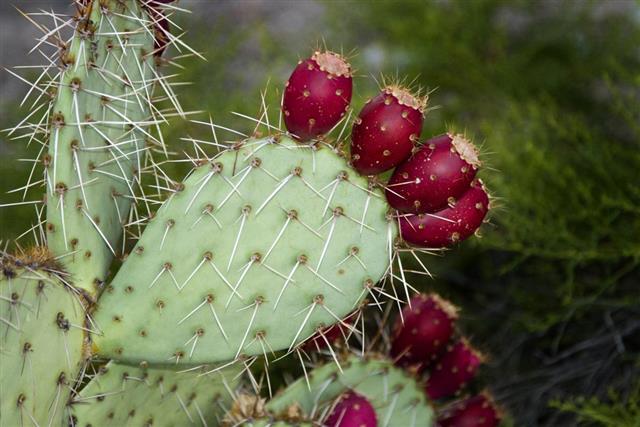
When talking about cactus care, one assumes watering it from time to time, is all the care such a plant needs. But caring for a cactus plant is a little more complicated than that, it involves providing the right light, soil and growing conditions. Scroll below to learn how to care for a fruit bearing cactus variety, the prickly pear.
Cactus plants are often dismissed as desert dwellers, hard, thorny plants that are useful only to poke innocent by-standers. But one member of the cactus family is the Opuntia, which is a genus consisting of 200 species. The common name for this breed of cactus is prickly pear, a cactus species native to Mexico. Members of this cactus family are known for their flat, round or oval-shaped pad like stems and their tuna or fruit, red or reddish orange in color. Care of cactus plants is usually easy and pretty basic but below is a detailed explanation on how to take care of a prickly pear cactus.
How to Grow Prickly Pear Cactus
The prickly pear needs a lot of sunlight, so make sure it is planted in a sunny area. This is one plant that can grow in the hottest part of your garden, so do not hesitate to plant it in a hot spot. Inadequate sunlight is obvious when the plant becomes thin and listless in coloring. According to USDA zoning, such cacti will flourish in zones 3-9. In warm and hot climates, plant the cactus in a slightly shady area to prevent it from getting sunburnt. This plant will grow in colder temperatures but harsh cold winds can shrivel the plant, so plant your prickly pear in a spot, well protected from the wind.
This plant is not at all fussy, when it comes to soil types. But opt for a well-drained loamy sandy or gravely soil, basically typical cactus soil is needed to grow this plant. The soil must drain easily. You can grow the prickly pear in a pot or in a soil bed, depending on its size. Larger varieties of the plant will grow in height and width, spreading and propagating rapidly, so a soil bed is better for such growth spurts. Bedding also strengthens the plants internally. But when potted, the prickly pear makes a very pretty addition to an array of potted plants, especially during the blooming season. They do not grow very tall.
This is a cactus plant and has small hairlike spikes called glochidiae or glochids, which can get stuck in skin and stay stuck for sometime. And pulling them out of your hand is not an easy job. Hence plant your prickly pear in an area where no one will accidentally hurt themselves or step on it. But this very prickly nature makes them ideal garden border plants and security plants to line a garden bed.
Prickly Pear Cactus Care
Water requirements of this plant are pretty minimal. These hardy cacti need to be watered once in 2-3 weeks, even in summer. If the plant is kept outside, then rainfall is enough for its hydration. Do not let water collect or pool in the soil. The plant will rot under such conditions. Too much water can cause the pads of the prickly pear to swell with moisture and break off. If their leaves turn crinkly or withered at the edges, it’s time to water them. Thin shriveled pads and droopy tips also means watering time. A hot humid day means water the cactus and in the winter, water them once a month.
Fertilizer can be applied depending on the season. A high nitrogen fertilizer should be used in case you want to consume or use the cacti stems. Such fertilization betters the quality of the stem for harvesting. If you prefer your cacti to flower and bear fruit, then apply no-nitrogen fertilizer once a month. These plants like to bloom between late spring and early summer.
For handling the prickly pear, one needs armor in the form of leather gloves or use 2 layers of cotton gloves. Wearing full-sleeved shirts is also a good idea, the less skin exposed, the less the prickly pear has to poke. Do not catch any part of the cactus with your gloved hands, use tongs or a piece of newspaper folded into half. Use a clean knife or saw to prune pads off. With fruit, the glochids growing on them will fall off once the fruit ripen. Twist the fruit for it to come off.
Propagation is very easy, just cut off a stem or a green pad, leave it to dry for a week and plant it in the ground. Even if you leave the pad on the ground, its roots will burrow in and start to grow. Water the pad sparingly for 2 weeks. You can even obtain seeds from the fruit of the cactus and sprinkle them into a soil bed or a pot.
The prickly pear has few threats to its well-being. One is the cochineal scale, which grows on the pads and looks like white, cotton balls. Blasting the cacti with water from a hose will shake them off. The mealy bug is another insect pest and diseases include leaf spot and soft rot. Over-hydration is a common issue, the roots of this cactus will rot and the cactus will collapse or contract inwards and die.
Prickly pear cactus is highly versatile in usage. A pad’s sap can be used to soothe wounds, similar to aloe vera sap. It is also used as a mosquito repellent. They can be eaten raw or cooked. The fruit of this cactus (pear or tuna) can be eaten and can be used in juices and culinary items. The usefulness and beauty of this plant along with its low-key maintenance has made the prickly pear cactus, a favorite cactus for horticulturists and gardeners alike, as long as those dreaded glochids are kept out of reach!



